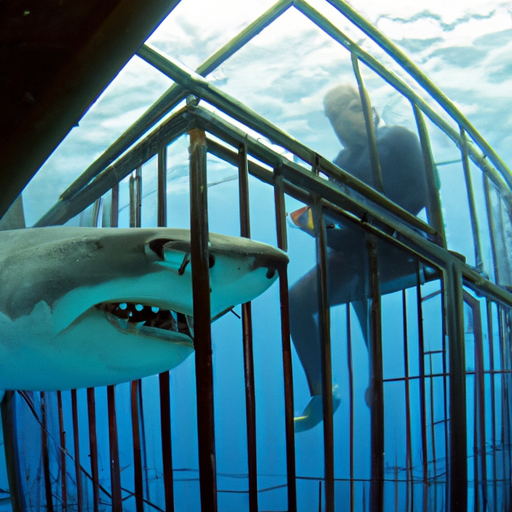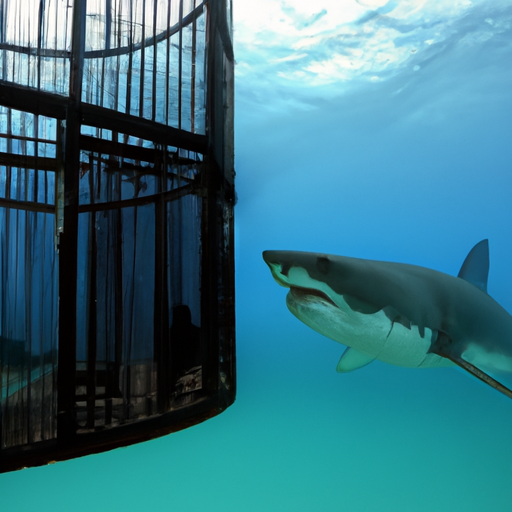So, you’re curious about shark cages and whether or not they provide protection. Well, let’s dive right into this fascinating topic. We all know that sharks are fierce predators of the sea, inspiring both fear and fascination. And when it comes to swimming in their territory, it’s only natural to wonder if a cage is a foolproof shield against their razor-sharp teeth. In this article, we’ll explore the effectiveness of shark cages and whether they truly keep you safe from these majestic yet perilous creatures. Brace yourself for some jaw-dropping discoveries!
The Purpose of Shark Cages
Protecting Divers and Researchers
Shark cages serve a vital purpose in protecting divers and researchers who venture into waters inhabited by these magnificent yet potentially dangerous creatures. By providing a physical barrier between humans and sharks, these cages significantly reduce the risk of shark attacks during underwater exploration. Divers can study sharks up close and personal while maintaining a safe distance, allowing for invaluable research opportunities without compromising personal safety.
Creating a Barrier between Humans and Sharks
The primary function of shark cages is to create a physical barrier between humans and sharks. The sturdy construction and design of these cages act as a deterrent, preventing sharks from entering the enclosed space and ensuring the safety of those inside. This protective barrier allows divers and researchers to observe and interact with sharks in their natural habitat without fear of direct physical contact or potential harm.
Studying Sharks in their Natural Habitat
One of the main benefits of shark cages is the ability to study these fascinating creatures in their natural habitat. By immersing oneself in the marine environment and using specially designed cages, researchers and divers gain unique insights into shark behavior, feeding habits, and social dynamics. This firsthand experience allows for more accurate and comprehensive scientific observations, contributing to a deeper understanding of these apex predators.
Different Types of Shark Cages
Surface Cages
Surface cages are the most basic form of shark cages and are typically used by operators offering shark diving experiences. These cages are buoyant and float on the water’s surface, providing an opportunity for divers and enthusiasts to view sharks from above. Surface cages are often made from sturdy materials such as steel or reinforced fiberglass, ensuring the safety of occupants and protecting them from potential shark encounters.
Submersible Cages
For a more immersive experience, submersible cages are employed. These cages are designed to be partially submerged, allowing divers to descend beneath the water’s surface and view sharks in their natural environment. Submersible cages are often attached to a boat or floating platform, and divers enter and exit through a secure hatch. This type of cage provides a unique vantage point for observing sharks while providing a safe and controlled environment for divers.
Baited Shark Cages
Baited shark cages are specifically designed to attract sharks to a specific area to allow for closer interactions and observations. These cages are equipped with bait, such as fish or other marine organisms, to lure sharks in close proximity. Once the sharks are in the vicinity of the cage, researchers or divers can study their behavior, feeding habits, and observe their natural instincts up close. Baited shark cages require careful management and adherence to safety protocols to ensure the safety of both humans and sharks.

Effectiveness of Shark Cages
Physical Protection
Shark cages are highly effective in providing physical protection to divers and researchers. The robust construction of these cages, often made with durable materials, ensures that the enclosure remains intact even under the force of a shark’s impact. The bars or mesh panels of the cage act as a barrier, preventing sharks from physically contacting or entering the cage, thus reducing the risk of injury or attack.
Reducing Escalation of Attacks
Another significant advantage of shark cages is their ability to reduce the escalation of shark attacks. By creating a physical barrier between humans and sharks, the presence of a cage can deter sharks from approaching or perceiving humans as a potential food source. This reduction in aggressive behavior contributes to a safer diving environment and minimizes the risk of confrontations between sharks and humans, as sharks are more inclined to move on without feeling threatened.
Minimizing Contact with Sharks
Shark cages serve as a deterrent, discouraging sharks from approaching divers and researchers in close proximity. The presence of a visible cage offers a visual marker for sharks, signaling that space is occupied and serving as a natural boundary. By minimizing direct contact with sharks, shark cages provide an added layer of safety and increase the chances of a successful and incident-free dive or research expedition.
Limitations of Shark Cages
Size and Agility of Sharks
Despite their effectiveness, shark cages do have their limitations, primarily due to the size and agility of sharks. Some shark species are large and powerful, capable of exerting force that could potentially compromise the integrity of the cage structure. Additionally, the agility and adaptability of certain sharks may enable them to find ways to breach or enter the cage, especially if the construction is not robust enough or if the sharks are highly motivated.
Breaching Incidents
Breaching incidents, where sharks propel themselves out of the water, pose a potential risk to shark cages. While these incidents are relatively rare, they can occur unexpectedly, especially during feeding frenzies or when sharks are in pursuit of prey. Breaching sharks may inadvertently land on or collide with the cage, potentially causing damage or compromising the safety of the divers or researchers inside.
Damaged or Compromised Cages
Regular inspection and maintenance of shark cages are crucial to ensure their effectiveness and safety. Over time, wear and tear, exposure to harsh marine conditions, and potential encounters with sharks can lead to damage or compromise the integrity of the cage. It is essential for operators and users to conduct regular inspections, repairs, and replacements as necessary to maintain the reliability and functionality of the shark cages.

Safety Precautions and Maintenance
Regular Inspections and Repairs
To ensure the safety of divers and researchers, shark cage operators must implement a rigorous inspection and maintenance schedule. Regular inspections can identify any signs of wear, damage, or potential weaknesses in the cage structure. Additionally, prompt repairs or replacements should be performed whenever necessary to address any issues and maintain the integrity and effectiveness of the shark cages.
Training and Experience of Divers
The training and experience of divers are critical factors in maintaining a safe shark cage diving environment. Divers should receive comprehensive training on shark behavior, safety protocols, and emergency procedures. Understanding how to interact with sharks responsibly and confidently can minimize the risks associated with cage diving. By adhering to guidelines and exercising caution, divers can ensure a positive and safe experience for themselves and the sharks.
Monitoring Environmental Factors
Shark cage operators must also be mindful of environmental factors that can impact the safety of divers and the welfare of sharks. Factors such as water visibility, weather conditions, and the presence of other marine life can influence the effectiveness and safety of cage diving. Operators should continuously monitor these factors and adapt their operations accordingly to ensure the well-being of both divers and sharks.
Instances of Shark Cage Failures
Close Calls and Near Misses
While shark cages are designed to be highly effective, there have been instances where close calls or near-miss incidents have occurred. These incidents typically involve sharks making contact with the cage, resulting in a moment of heightened danger. However, due to the robust construction of the cages, the occupants remain safe despite the close encounter. These incidents highlight the importance of proper cage design and construction to ensure successful protection.
Breaches Causing Injuries
Unfortunately, there have been incidents where shark cages have been breached, resulting in injuries to divers or researchers. These breaches can occur when sharks exert significant force or utilize unexpected methods to gain access to the enclosure. Such incidents emphasize the importance of ongoing improvements in cage design and protocols to prevent breaches and minimize the potential for injuries during cage diving activities.
Lessons Learned from Accidents
Every accident involving shark cages provides an opportunity to learn and improve safety measures. These incidents are thoroughly investigated, allowing researchers, cage operators, and divers to identify areas for improvement and implement changes accordingly. By analyzing accidents and adjusting protocols, the shark cage diving industry strives to enhance safety standards and ensure the well-being of both humans and sharks.

Alternatives to Shark Cages
Shark Repellents
Shark repellent technologies offer an alternative approach to protect divers and researchers by deterring sharks without the need for physical barriers like shark cages. These repellents generally use sound, light, or chemical deterrents to create an unfavorable environment for sharks, discouraging them from approaching or engaging with humans. While not as widely used or proven as shark cages, shark repellents are continually being developed and researched as potential tools to enhance shark safety.
Predator Deterrent Devices
Predator deterrent devices are another alternative to shark cages that rely on non-physical means to discourage sharks from approaching humans. These devices often utilize visual or acoustic signals to create a perception of intimidation or danger, dissuading sharks from any potential aggressive behavior. While they may not provide the same level of physical protection as cages, predator deterrent devices contribute to reducing the likelihood of shark encounters during diving or research activities.
Technology-Assisted Early Warning Systems
Advancements in technology have led to the development of early warning systems that use various sensors and surveillance equipment to monitor and detect the presence of sharks in the vicinity. These systems provide real-time alerts to divers and researchers, allowing them to adjust their activities or take evasive action if necessary. While still relatively new, early warning systems hold promise in providing an additional layer of safety and awareness for those in the water.
Controversies Surrounding Shark Cages
Ethical Concerns
Shark cage diving and the use of cages have sparked ethical concerns among conservationists and animal rights activists. Critics argue that shark cage diving can disrupt natural behavioral patterns, potentially conditioning sharks to associate humans with food. Furthermore, there are concerns about the impact of baited shark cages on the natural feeding habits of sharks and the potential alteration of their migratory patterns. These ethical concerns highlight the importance of responsible and regulated shark cage diving practices.
Impact on Shark Behavior
The influence of shark cage diving on shark behavior remains a subject of ongoing scientific research and debate. Some studies suggest that prolonged exposure to cage diving activities could alter the behavior of sharks, making them more inclined to approach boats or humans in search of food. However, more research is needed to fully understand the implications and potential long-term consequences of shark cage diving on shark behavior.
Educational Value vs. Ecotourism
Shark cage diving offers a unique opportunity for education and raising awareness about these magnificent creatures. Many argue that by immersing individuals in the marine environment and allowing them to witness sharks up close, shark cage diving can foster a connection, respect, and understanding for these often misunderstood animals. However, critics question the fine line between the educational value of shark cage diving and its potential exploitation as a form of ecotourism. Striking a balance between responsible conservation practices and commercial interests is crucial for the long-term sustainability of shark cage diving.

Regulations and Guidelines for Shark Cage Diving
Permits and Licenses
Due to the potential risks associated with shark cage diving, permits and licenses are usually required by regulatory bodies to ensure safety and adherence to guidelines. These permits outline the specific conditions, limitations, and required safety protocols that operators must follow to conduct cage diving activities. Obtaining such permits involves demonstrating compliance with relevant laws and regulations, including environmental protection measures and conservation efforts.
Code of Conduct for Operators
To promote responsible and ethical shark cage diving practices, industry-specific codes of conduct are often established. These codes outline specific guidelines, procedures, and expectations for operators to follow, ensuring the well-being of both humans and sharks. Compliance with these codes helps maintain safety standards, minimizes impact on shark behavior, and contributes to a sustainable and responsible shark cage diving industry.
Interaction Guidelines for Divers
Divers engaging in shark cage diving activities must adhere to specific interaction guidelines to maintain their safety and minimize disruptions to the natural behavior of sharks. These guidelines typically include maintaining a safe distance from sharks, not touching or provoking them, and respecting their territory. Following these guidelines promotes a positive and respectful coexistence between humans and sharks, enabling divers to experience the beauty of these creatures without compromising their well-being.
Conclusion
Shark cages serve a crucial role in protecting divers and researchers while studying sharks in their natural habitat. By creating a physical barrier between humans and sharks, these cages reduce the risk of shark attacks, allowing for up-close observations and research opportunities. Despite their effectiveness, shark cages have limitations, particularly related to the size and agility of sharks, breaching incidents, and the need for regular maintenance. However, through careful inspection, training, and monitoring, the safety of shark cage diving can be enhanced.
While alternatives to shark cages, such as repellents, deterrent devices, and early warning systems, continue to be developed, shark cages remain a widely utilized method for protecting humans and studying sharks. The controversies surrounding shark cage diving, including ethical concerns and potential impacts on shark behavior, highlight the need for responsible practices and ongoing research.
Regulations and guidelines, including permits, codes of conduct, and interaction guidelines, play a vital role in ensuring the safety and sustainability of shark cage diving. Striking a balance between adventure and safety, ongoing research, and innovation will pave the way for a future where humans can explore and study sharks while maintaining a respectful coexistence with these magnificent creatures.

- Can You Dive With Sharks In California? - August 19, 2023
- What Are The Rules Of Shark Cage Diving? - August 19, 2023
- Where In Florida Can You Dive With Sharks? - August 19, 2023








